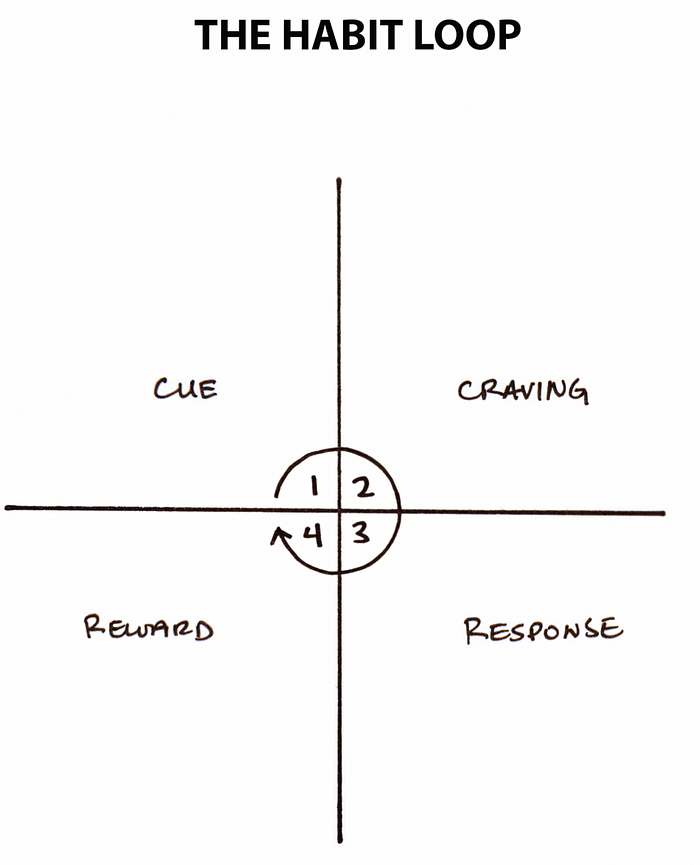Hack Your Habits for a Balanced Digital Diet
“You become what you give your attention to…If you yourself don’t choose what thoughts and images you expose yourself to, someone else will.”
— Epictetus, O.G. Greek Philosopher

You’re familiar with this pattern: You’ve got something you need to work on, an important assignment for work or school. You sit down and decide to get started.
You’re ready.
You’re in the zone.
It’s time to focus.
Ten seconds in: BZZZZZZ! Without giving it a second thought, reflexively, you pick up your phone and see what the fuss is about. A half hour later you put your phone down and don’t even remember why you picked it up in the first place, but for some reason unexplained reason you now know that the guy you went to high school with had sushi for dinner last night.
Okay, now it’s time to focus.
For reals this time.
A few minutes later: BZZZZZ! Rinse and repeat. On a bad day, I’d go through this series of events in an endless loop, resulting in an embarrassingly minuscule amount of actual productivity. For the longest time I chalked it up to a self-diagnosed case of ADHD and I got by the best I could. It wasn’t until I read Atomic Habits by James Clear that I considered that this was actually a series of habits wired in my brain that I’d be able to reprogram with a little self awareness and a bit of effort. I do still have those bad days, but I’ll share 3 strategies that have helped those bad days be less bad.
“BZZZZZZ!” — algorithms, trying to control your behavior
First, a Quick Recap on Habits
One of the main takeaways from Atomic Habits is that habits, good or bad, are essentially neurological feedback loops. For any given habit, a cue triggers a craving that motivates a response to get a reward. For example, in the case of social media: a notification on my phone (cue) reminds me of whatever warm fuzzy feeling I get from a like or retweet (craving) and causes me to open an app (response) so that i can feel that warm fuzzy feeling (reward).

Our days are chock-full of these feedback loops and we don’t even realize it. Take the classic fridge example. Have you ever walked to the kitchen and opened up the fridge 100 times a day even though you already know what’s in there? Yep, that’s an automated feedback loop where the cue is your location in the kitchen, the craving is something yummy to put in your tummy, the action is opening up the fridge and the reward is supposed to be food, which may or may not be there.
So knowing this, let’s see if we can exploit this loop so that maybe you don’t pick up your phone in the first place.
Curb the Cue: Nix Your Notifications
John Oliver had a delightful segment about push notifications and he nails it. What started out as a really nifty feature has devolved into a way for thirsty corporations desperate for clicks to trick you into unlocking your phone and interacting with their product to sell you things you probably don’t need. It’s time to stand up to those apps and say “no, not today.”
Most apps have notification options, or you can simply block them on the operating system level on both Android and iOS. Once you get rid of the notifications, the buzz buzz that triggers you to check your phone is gone gone. We’ve eliminated the cue!
At this point you’re probably thinking to yourself, well duh. I know this isn’t a groundbreaking strategy. Well hold on. Sometimes this isn’t enough. I realized that after nuking my notifications, I was still mindlessly scrolling, swiping and tapping. And that’s because sometimes the cue isn’t as obvious as a notification. When I was already on my phone, just the mere presence of the app’s aesthetically pleasing icon on my home screen was a cue, reminding me to tap that app. So, what can we do about that?
Rein in Your Response: Anchor Your Apps
I’ve been off of Facebook for about 2 years now, but I’m not here to tell you to #DeleteFacebook (you totally should though) or any other social media service for that matter. There’s a nice middle ground to keep your digital addictions in check, and it targets your response to the craving.
Way back before we could fit it in our back pockets, the internet was anchored to a chunky box sitting in our homes. As a teenager, I had a home PC. If I wanted to check my MySpace and update my top 8 (younger readers can look this up) I couldn’t do that in the middle of the day while waiting in line at the grocery store as soon as the thought popped in my head. Nope, I had to wait until I got home to my beloved chunky box. And even then, before broadband was available in my neighborhood, I had to wait ages for my mom to get off the phone. Those days it was a little harder for social media to become a bad habit in the first place. In hindsight, it was nice.
We can recreate this mindset with a bit of effort. I won’t suggest that you uninstall every single smartphone app from your phone, that’s crazy talk. But how about this: choose 1 or 2 apps that frequently take your attention hostage and remove them from your phone. Once you’ve done that, create a new habit of only accessing those apps or websites from a device that you don’t carry around all day, like a tablet, laptop, or PC. Truthfully, some of them are better in a browser anyway. This works great for news apps, especially if you’re trying to detox from the American news cycle. It also works great for Twitter if you’re okay with not live tweeting your day to day. By doing this, now you’re really telling those apps who’s in charge of your attention. Fun fact: Chrissy Teigen tweets from a computer, so maybe she’s got the right idea.
Establish a No Phone Zone
Remember the example I mentioned about the fridge in the kitchen? Well if you wanted to break that habit of mindlessly opening the refrigerator over and over again, one way of doing it is by straight up removing it from the kitchen. Boom, problem solved. That strategy isn’t very practical for refrigerators but works great for phones.
I used to charge my phone overnight right next to my bed. On some mornings after snoozing and then dismissing my alarm, I’d just lay there mindlessly scrolling through feeds and half-assedly reading the breaking news of the day (it’s never good). The fact that this would happen first thing in the morning meant that my mood at the start of my day was at the mercy of whatever content some algorithm decides I should care about.
Nowadays, I place my phone on the other side of the room and as soon as I wake up, I dismiss the alarm and start my day. I don’t even check my messages or apps for another few hours on a typical day. This empowered me to keep my mind clear and have a morning routine that isn’t dictated by apps. Even before bed or during the day, I’m committed to never using my phone near my bed. If you’re in a relationship, bonus points if you can convince your significant other to do the same (good luck).

Of course your no phone zones can be wherever you’d like: the desk where you do your work, the table where you eat your meals, the bathroom where you.. well you get the point. It doesn’t matter where your zones are, what matters is that you have them so that you can interrupt the attention-stealing habit loop and give you a moment to yourself to be present in the real world.
Revisit and Revise
So these are just three strategies you can try out to keep your digital diet in check. They’re not perfect and there are tons more. Some days you’ll look back and shake your head at the 2 hours you spent on Reddit between the 3 hours you scrolled on Facebook. Then maybe you’ll tweet about it. That’s fine.
If nothing else, the one thing you should definitely try to do on occasion is revisit the habit feedback loop and see where you can tighten up and take control. It’ll at least remind you to be mindful of the time you spend with your face inside a screen, and hopefully free yourself from its spell.
Okay, back to work!
